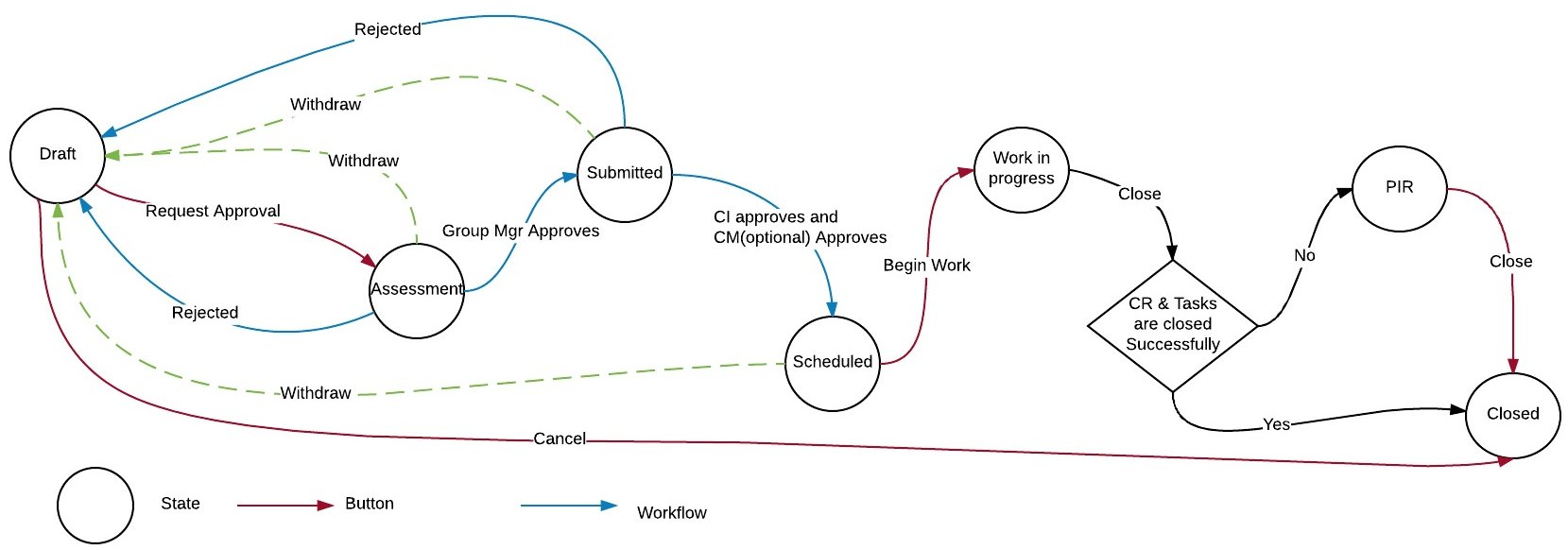Note: Change Requests which impact either Hospital (SCH or SHC) should be indicated by the Change Owner (Assigned to) by including the org(s) in the "Impacted orgs" field on the Change Requst. This will add responsible people to approve insuring that the Change has been reviewed by the Hospital CAB(s) in addition to any requirement for UIT CAB.
| State | Possible Transitions |
|---|---|
| Draft | When a Change is created, it starts in the Draft state. The "Draft" state allows the Change Request to be configured at a later time where additional details can be added. When the Change Request is ready, the Change Owner (Assigned to) can "Request Approval". Change Types: Normal, Expedited, Emergency, Standard, Informational |
| Assessment | The first step in the Change Request workflow is Assessment. During this step the Change Request is reviewed by the "Assessor" (or "Alternate assessor") who insures that all elements of the change are correct. This includes "Risk Assessment" answers (sets "Risk/Impact" rating), "Risk and impact analysis", "Planned start date", "Outage" (if appropriate), etc. The Assessor has the ability to modify Change Request if needed to make needed corrections instead of returning the Change Request to the Change Owner (Assigned to). Change Types: Normal, Expedited, Emergency, Standard, Informational |
| Submitted | The second step in the Change Request workflow is Submitted. There are multiple types of approvals in this status. Approvals start with Risk/Impact level approver(s) first, the move to the UIT Change Management group (for Risk/Impact Very High and High) and then to any 'ad hoc' approvers added to the Approver related list.
Approvers are not allowed to make changes to the Change Request, instead must Reject the change if any adjustments are needed. Change Types: Normal, Expedited, Emergency |
| Scheduled | After all approvals are completed, the Change Request becomes Scheduled. Stays in this state until the Planned Start date (and time). Change Types: Normal, Expedited, Standard |
| Work in Progress | After all approvals are completed, the Change Request becomes Scheduled. Stays in this state until the Planned Start date (and time). Change Types: Normal, Expedited, Standard |
| PIR (optional) | After the Change Request has been marked as "Closed" by the Change Owner, the Change Request may enter a state of PIR (Post Implementation Review). Stays in this state until the UIT Change Management group completes PIR. It may enter PIR automatically if the Change Request is and Emergency Change or if any change type is set to Closed Unsuccessful or if one of the Change Tasks is set to Closed Unsuccessful or Closed Canceled. The UIT Change Management group may also manually set the PIR field to required. Change Types: Normal, Expedited, Emergency |
Closed
| In order for a Change to be closed, the Change Owner (Assigned to) must select the Close Code and enter Close notes. Once the Change Request has been Closed (Successful, Unsuccessful, Canceled) no more changes to the Change can be made unless the Change Request must undergo PIR. Note: In order to "Cancel" a change request, the "Assigned to" must first Withdraw the Change Request which places it into Draft state. Changes that have begun can not be Withdrawn and therefor must be "Closed Unsuccesssful". Change Types: Normal, Expedited, Emergency, Standard, Informational |

